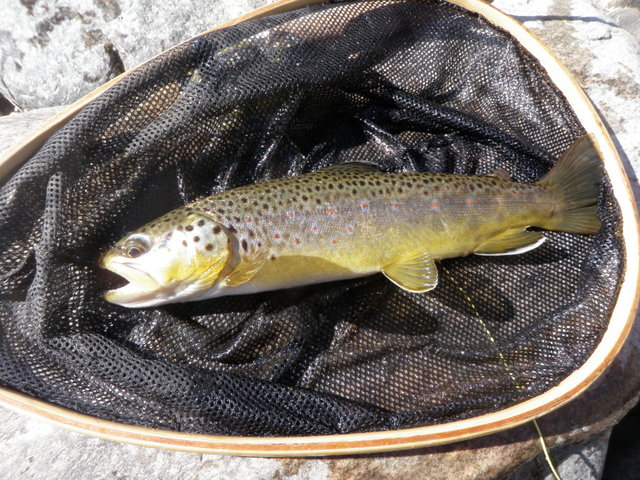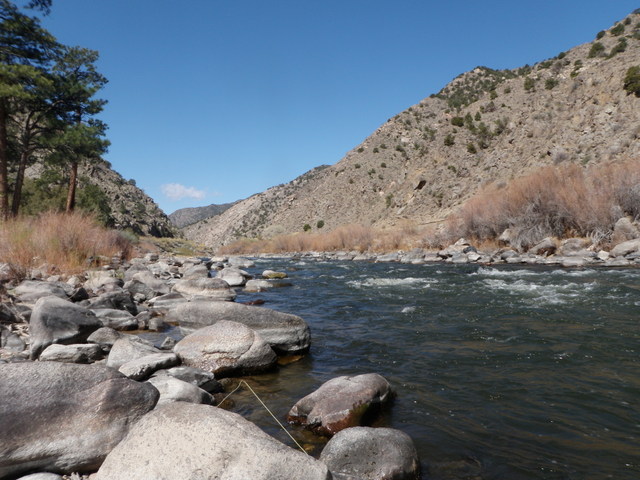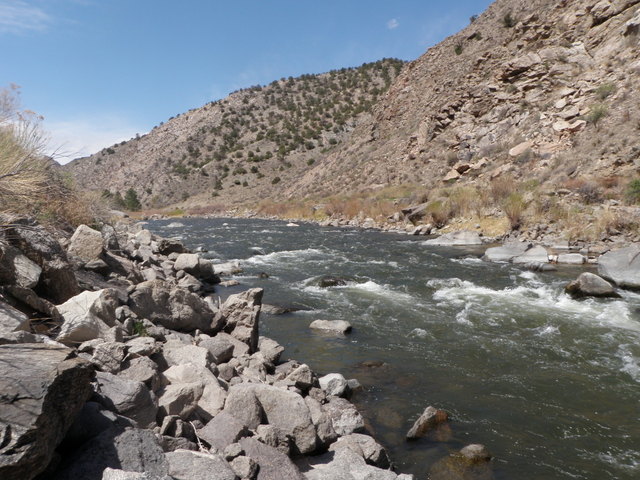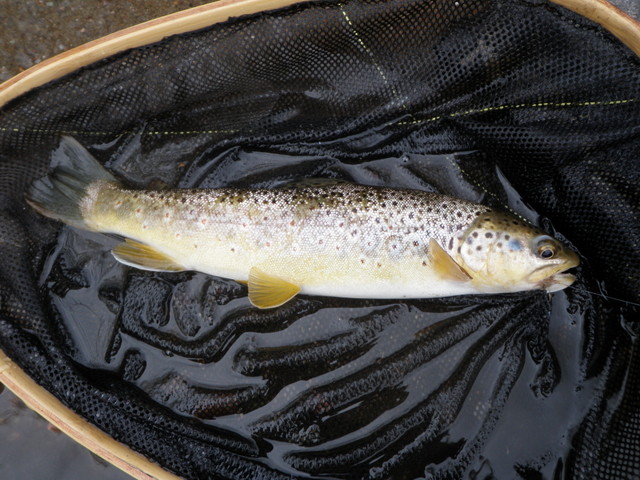Time: 10:30AM – 5:00PM
Location: Between Spike Buck and Five Points
Fish Landed: 32
Arkansas River 04/13/2012 Photo Album
Are you superstitious? If so, then it probably isn’t a good idea to take a long drive to go fishing on Friday the 13th, but I did exactly that. Perhaps the bad luck manifested itself in the number of times I snapped off my flies. As I recall I snapped off both flies twice on fish while playing them and at least four times when snagged on assorted sticks and rocks in the river. Fortunately the Arkansas River is wide open and doesn’t pose much of a risk of snagging streamside vegetation or I would have experienced that roadblock as well. On two occasions I broke off two flies along with two split shot requiring a complete start over from a fly rigging standpoint.
Friday the 13th, however, did not seem to affect the number of fish I landed. It was a great day on the Arkansas River. Although I didn’t encounter the magical brachycentrus caddis emergence, I caught a bunch of fish anyway and did find a different caddis hatch that was fun and exciting albeit not as dense as the brachycentrus hatch.
High temperatures in Denver and probably along the Arkansas River as well did not reach above the mid-60’s on Friday. It was cool and breezy all day and I wore a fleece in the morning and a rain jacket in the afternoon. I arrived at my target stretch above Spike Buck and was on the water fishing by 10:30AM. There were quite a few other fishermen on the river, but not the large numbers that inhabit the area when the main caddis hatch is on. The day can be clearly divided into three distinct segments.
I stopped at the Royal Gorge Angler fly shop on my way to the river and purchased three Arkansas rubber legs as well as the materials to tie my own for the future. I began fishing above Spike Buck where I’d ended my day on my previous trip on April 6, and tied on one of the Arkansas rubber legs that I’d just purchased. To the bend of the stonefly imitation I tied an 18 section of tippet and added an emerald caddis pupa. I fished for around fifteen minutes when the indicator paused and I set the hook and landed my first brown of the day on the emerald caddis. I moved on fishing all the nice pockets and runs along the bank and by 11AM I landed a second brown on the caddis pupa.
However, I felt like I was moving along too rapidly through some very attractive water without action, and the rubber legs wasn’t producing, so I decided to remove the large weighted fly and go to two smaller flies. I replaced the weighted fly with two split shot and tied on a bright green caddis pupa as the top fly and returned the emerald caddis pupa to the point position. Things began to pick up after this move, and I also discovered two techniques for giving the flies movement that seemed to be very effective. For upstream casts, I twitched my rod tip up and down as the flies drifted back toward me, thus creating a jigging action. On casts straight across I began making quick jerky downstream mends. This is the exact opposite of what a fisherman strives for to create a desirable drag free drift, but it was effective during the caddis activity period. Both techniques were quite effective and I landed another five fish bringing my total to seven as I approached a long slow deep pool.
I decided to skip the pool and focus on the faster runs and pocket water with my wet fly techniques, but as I climbed the rocks along the bank, I was startled to hear a voice. Another fisherman was quietly standing along a large ledge rock waiting for me to pass, and I hadn’t seen him as I was focused on climbing the jagged rocks. We exchanged greetings, and he asked how I was doing, and I told him I’d caught seven and described fly movement as my key to success thus far.
Once I’d reached the top of the long pool, I resumed fishing with my jigging and swinging techniques. Just before noon I hooked what felt to be a nice fish on a bad mend, but the fish immediately headed for the heavy current and went downstream. I began a feeble attempt to climb down the rocks so I could follow downstream, but before I made more than a step or two, I must have moved the rod back towards me for a moment and the fish snapped off everything; two split shot and two flies.
I sat on a rock and performed a totally new rig, but this time I tied on an ultra zug free-living caddis. I made five of these flies during my winter fly tying, and it looked like a winner with a black plastic bead and bright green body with a crystal flash rib. I tied a new emerald caddis on as the point fly. Over the next twenty minutes or so I fished up along the left bank to a point across from a gray box next to the railroad tracks and landed two more brown trout. These fish much to my surprise inhaled the ultra zug nymph even though it was the top fly, and both hammered it on a dead drift. My first segment of fishing was defined by imparting action to a pair of flies wet fly style to prompt takes.
At noon I climbed up the steep bank and returned to the car where I grabbed my lunch. I decided to drive up the highway to the next pullout as I was planning to continue fishing upstream from where I ended my morning. However, when I parked in the pullout near another vehicle, I observed three fishermen lined up along the bank so I made a U-turn and headed back east where I found a nice pullout halfway between where I intended to begin fishing and the occupied area. As is my usual practice I took my lunch and water bottle to a position next to the river so I could observe while eating.
After lunch I returned to my end point from the morning and initially continued fishing in the manner I’d adopted earlier. However fairly early in the process I snagged bottom and tore off my flies. I was pretty upset to lose the ultra zug, and as I tied on new flies, I decided to tie on another but replace the emerald pupa with a bright green pupa. If the bright green ultra zug was working, why wouldn’t a bright green pupa work as well? This turned out to be a great move and I landed many of my fish between noon and 4PM on the bright green pupa.
As the afternoon progressed the sky grew cloudier and I began noticing an increasing number of caddis dapping the water. The air temperature was also dropping and I was glad I still wore my rain jacket. I worked my way through another deep pool where the three fishermen had been positioned and then a wide shallow stretch with a small island next to another large pullout. In the early afternoon I was discovering that I didn’t need to impart as much action to my flies and the most productive areas were fairly shallow riffles over gravel bottoms. In two or three cases my indicator paused, so I attempted to lift my line thinking I was hung up on the bottom due to the shallow depth only to discover that I hooked a nice brown trout.
Between 1 and 3:30 I landed another eleven fish to put me at twenty on the day, and I was feeling quite satisfied with this achievement in spite of the lack of a dense caddis hatch or even a blue wing olive hatch. Most of the fish took the bright green caddis, but I did catch a couple on a beadhead RS2 which I added for awhile thinking perhaps the BWO nymphs were active and in the drift. It was getting quite chilly and windy as I turned a corner in the river, and I could see the Five Points recreation area 150 yards upstream, so I decided I’d quit for sure at 4PM for the long drive back to Denver. I wasn’t having much luck as I covered half the distance to Five Points, but began to see an increasing number of caddis on the willows and dancing on the water. Suddenly I spotted a few sporadic rises, and then as I approached a nice stretch of water, I saw quite a few rises.
The area I was below was a classic small pool in the shape of a fan with the faster current spreading out around several large boulders. I decided to clip the subsurface imitations and give a caddis dry fly a try. Sure enough on the first cast of a dark olive deer hair caddis at the tail of the pool, a small brown tipped up and sucked it in confidently. I released the fish and dried my fly and got it back on the water quickly and was rewarded almost instantly with another fish. I extracted around six fish from this beautiful water, but towards the top of the pool snapped off my fly. I replaced it with a slightly larger and bushier caddis with a palmered body. This fly produced equally well and added another three fish, but while trying to extract the fly from the mouth of a fish I was having difficulty and managed to pull all the wing fibers from the fly. By now my hands were quite wet and raw from the cool air and wind and constantly dipping in the water to release fish.
I tied on a third deer hair caddis and worked up through two or tree additional pockets and picked off another three fish. I was now within thirty yards or so of the Five Points platform that juts over the river, and there were quite a few people ahead, and my hands and body were approaching shivering status so I reeled up my line and called it a day. Twelve fish in the last hour on caddis dry flies was an exciting and unexpected end to my fabulous day on the Arkansas River.




